October 2021
1. The labour market continues to recover although employment remains below pre-pandemic levels
Employment rose by 235,000 in June to August 2021 compared to the previous quarter but remains 657,000 lower than before the pandemic. The timelier but less comprehensive measure of PAYE employees increased by 207,000 in September 2021 compared to the previous month and is above its pre-pandemic level.
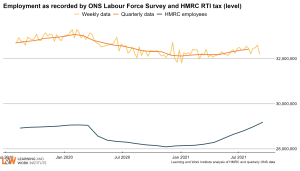
2. Despite strong employer demand, 3.2 million people are either unemployed or want to work
Vacancies remain at record levels and 39% above pre-pandemic levels, with more than one million online vacancies recorded in early October. While this varies by sector and geography, vacancies are higher in almost all sectors and areas of the country than pre-pandemic. Anecdotal reports suggest employers are struggling to fill vacancies in some sectors and areas, with HGV drivers being the most high profile example.
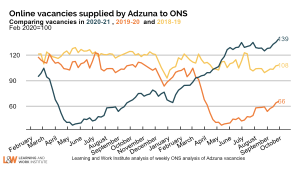
However, this is not because of a shortage of workers: overall there are 3.2 million people who are either unemployed or economically inactive but want a job. The challenge is matching those who want a job with roles that are available. In some cases this is a skills mismatch, in others employers need to think about their offer to potential employees in terms of wages but also how people can fit jobs around caring responsibilities or other personal circumstances.
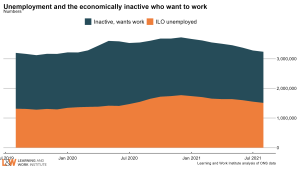
In addition, we need to accelerate our efforts to support those who are out of work to look for jobs. The number of people claiming unemployment-related benefits fell by 51,100 in September 2021 compared to the previous month, meaning the number of people claiming benefits both in and out of work now stands at 2.11 million.
Strikingly this is 603,000 above the survey measure of unemployment, having been below this measure for most years prior to the pandemic. This suggests there are significant numbers of people who are classed as receiving unemployment-related benefits, but who are not either looking for work or available to start work. The Government has invested in increasing Jobcentre Plus capacity and new employment programmes. This support needs to deliver.
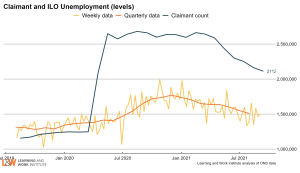
3. Average earnings are not rising as fast as the headline data suggest
Average earnings rose 5.6% (2.7% after accounting for inflation) in the year to August 2021. However, this is distorted by:
- compositional changes: people on the lowest incomes have been most likely to lose their jobs
- base changes: a significant number of people who faced drops in income while furloughed will now have returned to their previous jobs and pay levels.

Taking account of inflation, average weekly earnings have been flat since December 2020, though are up 4% on pre-pandemic and there will be significant variations by sector, role etc.
4. Around one million people were likely furloughed as the scheme came to an end, although long-term unemployment has stabilised
At the end of August 2021, the total number of people furloughed stood at 1.32 million, of whom 728,000 were fully furloughed. Survey data suggest this may have fallen further by the scheme’s end at the end of September 2021. Older people were more likely to be furloughed than younger people, in contrast to earlier in the pandemic. It is uncertain how many people furloughed at the scheme’s closure will return to their previous jobs, have found new jobs, or will be out of work. The Government needs to ensure those who lose their jobs are supported to find new work, rather than dropping out of the labour force.
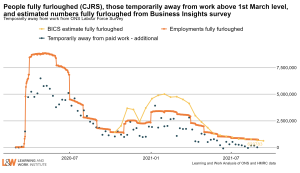
Long-term unemployment is a particular concern as it reduces people’s chances of finding work and can reduce their health and wellbeing.
Long-term unemployment rose significantly through the pandemic, but is showing signs of stabilising. The number of people aged 25 and over who are long-term unemployed, defined as out of work 12 months or more, has risen 112,000 (47%) since the pandemic started (Dec 19-Feb 20). Youth long-term unemployment (defined as six months or more out of work) is up 25,000 (17%) since the pandemic began.
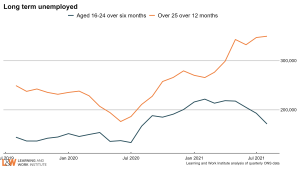
5. Employment for young people is recovering after sharp falls, with participation in education also rising
Employment fell most sharply for young people during the pandemic, in part as they were most likely to work in shutdown sectors like retail and hospitality. Employment for young people is recovering as the economy reopens. However, young people account for 37% of the fall in employment, despite accounting for just 11% of total employment. As a result, the number of unemployed 16-24 year olds rose during the pandemic. However, it has fallen recently as the economy has reopened and young people have been more likely to stay in education, and now stands at 498,000 (15,000 lower than pre-pandemic).
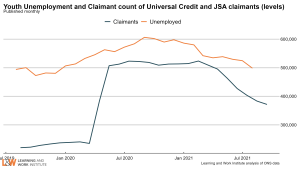
A greater proportion of young people have remained in or returned to education during the pandemic. The percentage of 18-24 year olds in full time education has risen from 31.7% in June 2020 to 36.3% in June-August 2021. In turn, figures for those not in full time education have declined. Provided they are in high quality education that suits them, this can benefit their future prospects and help to narrow our education gaps with other countries.
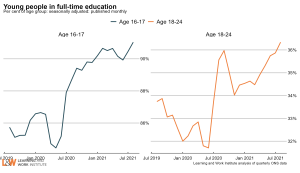
A Youth Guarantee is needed to ensure that all young people are offered a high quality job, training place or apprenticeship – join us to discuss this at the Youth Employment and Skills Summit with the Minister for Employment and others next Wednesday.